Located in the spiritual heartland of Bhutan, in the serene district of Bumthang, the Wangduechhoeling Palace stands as a timeless symbol of Bhutanese culture and history. This architectural gem, once the royal seat of power, has undergone a remarkable transformation into a vibrant museum and cultural hub. Visiting Wangduechhoeling Palace is not just a journey through space but a passage through time, offering an in-depth look into the country’s monarchy, heritage, and artistic traditions.
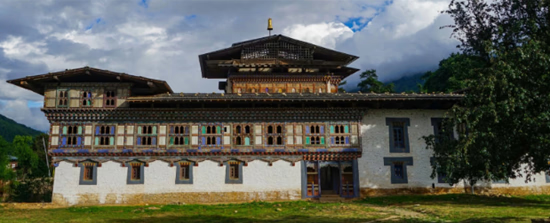
A Historic Treasure
Built in 1858 by Jigme Namgyel, the father of Bhutan's first king, Wangduechhoeling Palace holds a significant place in the nation’s history. It was here that Gongsar Ugyen Wangchuck, Bhutan’s first monarch, was born. The palace is an exemplar of Bhutanese architectural excellence, designed in traditional Bhutanese style with intricate woodwork, religious paintings, and exquisite carvings. Jigme Namgyel, a national hero, is credited with unifying Bhutan and laying the foundation for the Wangchuck monarchy. From a young age, he fought in multiple conflicts, including battles against the British and other feudal lords, eventually rising to become a provincial governor. Wangduechhoeling Palace was built on the site of one of his key victories over another province’s governor. The name "Wangdue" means "victory," while "Chhoeling" refers to "a place rich in Buddhism."
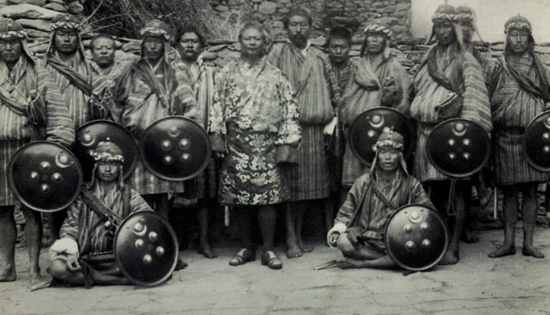
For over a century, the palace was not just a royal residence but the epicentre of national power. However, after the royal family moved and the capital shifted, the palace fell into disrepair, its grandeur fading with time. The loss of its original splendour remained a deep cultural wound for many years until efforts to restore and preserve it began. In 1857, a dramatic battle saw Jigme Namgyel becoming the secular leader of Bhutan, ending two decades of civil strife and paving the way for the establishment of the Wangchuck Dynasty.
Ugyen Wangchuck was born in 1862 in the Wangduechhoeling Palace, where he would later be elected Bhutan’s First King in 1907. After his mother’s death he moved out of the Palace and relinquished it to his sister, Ashi Yeshey Chodron.
The Restoration: A New Beginning
Recognising the cultural and historical importance of the Wangduechhoeling Palace, the Bhutan Foundation, in collaboration with the Department of Culture, launched a restoration project in 2012. This monumental effort was guided by Her Majesty Queen Mother Gyalyum Tseyring Pem Wangchuck, whose dedication helped transform the palace into the masterpiece it is today.
The restoration was a painstaking process, with every detail carefully considered. The palace's decaying wooden beams were replaced, and the walls and surfaces were meticulously restored using authentic mineral rock pigments. In a bid to adapt to modern needs, the project also incorporated fire safety systems and accessibility features, ensuring the palace remains a model for the preservation of heritage in Bhutan.
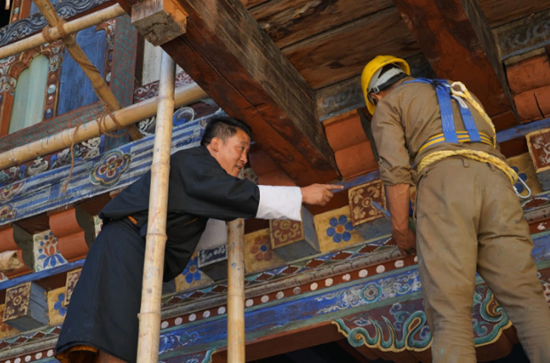
A Monumental Restoration Effort
The restoration of Wangduechhoeling Palace has involved major renovations to address the rotting wooden beams, damaged stone inlays, and overall structural integrity of the building. The restoration team also rejuvenated 31 rooms that contain intricate paintings, carvings, and designs. A key aspect of the project has been the enhancement of accessibility and fire-safety features, ensuring the building is both functional and safe for visitors while maintaining its historical authenticity. Once a fully sustainable homestead for the monarchy, the palace is set within expansive grounds that boast several notable features, including:
-
A traditional archery ground for the practice of Bhutan’s national sport.
-
Lingka Lhakhang, a monastery that adds to the spiritual significance of the site.
-
Five water-powered prayer wheels (Chhukhor Mani), which offer a tranquil atmosphere for reflection.
-
Choeten Maap (Red Stupa), a Buddhist monument of great importance.
These spaces are being restored as part of the project, and a cafe is also being added for visiting guests, offering a space for relaxation and reflection amidst the cultural richness of the palace grounds.
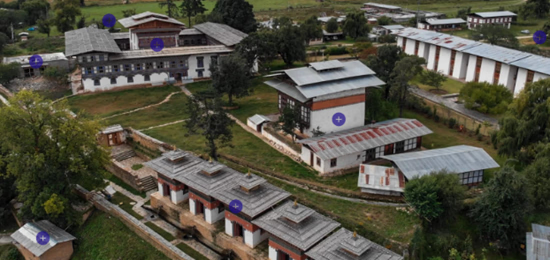
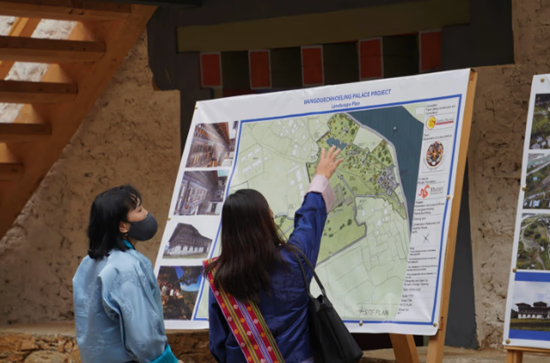
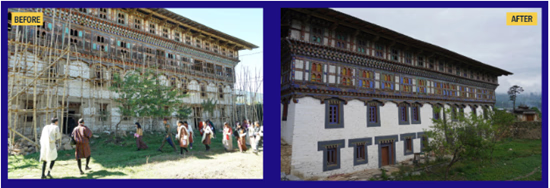
Museum Design Approach
The newly restored Wangduechhoeling Palace will function as a modern museum and cultural centre, offering visitors a deep dive into Bhutanese history, Buddhist values, and the living arts that form the foundation of Bhutanese culture.
The design approach for the museum focuses on maintaining the palace’s original internal layout while integrating rooms from different historical periods. It will feature immersive contextual environments that reflect the diverse historical and cultural phases of Bhutan. The exhibits will be designed with layered storytelling, blending historical facts with folklore and oral traditions, providing visitors with a well-rounded view of Bhutan’s past and present. Incorporating universal design principles, the palace will be accessible to all visitors. Features like wheelchair ramps, audio captions, and spaces designed for children, the elderly, and people with disabilities will ensure that everyone can enjoy and engage with the museum’s offerings.
The restoration of the architecture and paintings has been carried out in strict adherence to conservation principles. The aim has been to preserve the palace’s authenticity with minimal intervention, making it a model example of how to restore heritage structures while maintaining their historical integrity. This approach ensures that the palace will continue to serve as a bridge between Bhutan’s rich past and its dynamic future.
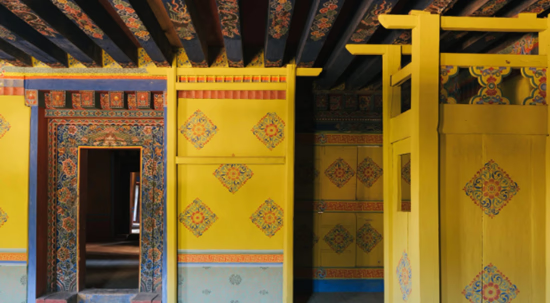
A Seamless Blend with Nature
Throughout the restoration and redesign, a conscious effort was made to keep the design unobtrusive. Every element, from lighting to landscaping and exhibition plans, was carefully considered to blend harmoniously with the natural surroundings. The goal was to retain the palace’s heritage status and ensure that it remains an integral part of Bhutan’s cultural landscape for generations to come. The Wangduechhoeling Palace now stands as a testament to Bhutan’s commitment to preserving its history, culture, and architectural heritage, offering both locals and visitors a chance to engage with the nation’s past in a meaningful and respectful way.
The Wangduechhoeling Palace Museum and Cultural Centre
In 2024, after years of restoration, the Wangduechhoeling Palace was reborn as the Wangduechhoeling Palace Museum and Cultural Centre. Officially consecrated in a grand ceremony attended by Her Majesty Queen Jetsun Pema, the transformation was truly remarkable. The once dilapidated palace has been restored not just to its former glory but is now a living, breathing institution that celebrates Bhutanese history, art, and spirituality.
The museum’s galleries take visitors on a journey through Bhutan’s history, showcasing a range of artefacts, manuscripts, paintings, and religious relics. Among its treasures is the sacred Tashi Gomang, a rare travelling shrine that represents Guru Padmasambhava’s copper-coloured palace. Only 35 of these sacred relics exist in Bhutan, making it a precious addition to the museum’s collection.
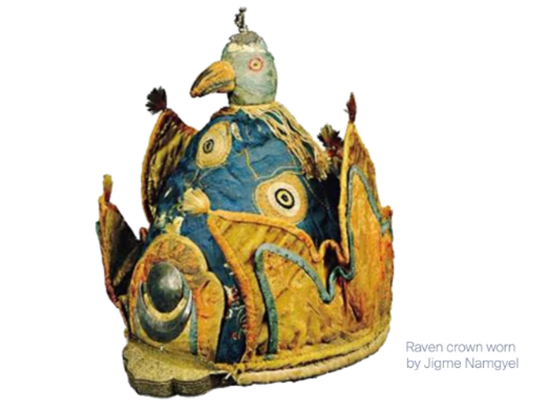
An Immersive Experience
Wangduechhoeling Palace is a place where history comes to life. Interactive displays and immersive exhibits offer a deep dive into the rich culture of Bhutan. The museum not only delves into the history of the palace itself but also provides insight into the broader historical context of Bhutan and the Bumthang region.
For those with an interest in Bhutanese art and religious practices, the palace provides a rare opportunity to explore intricate religious artefacts and sacred objects. The exhibits bring to life the spiritual side of Bhutan’s culture, with representations of Buddhist teachings, symbols, and the country’s rich religious heritage.
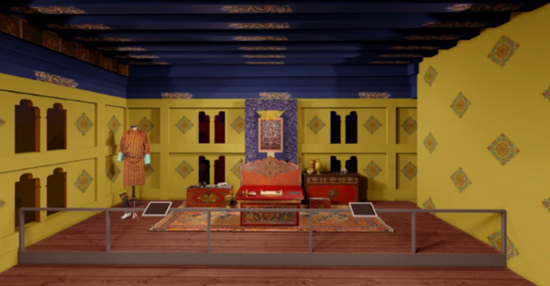
The Surroundings: A Cultural Oasis
Beyond the palace’s walls lies a tranquil expanse of land—spanning over 20 acres—that is gradually being transformed into a cultural oasis. The grounds surrounding the palace are set to include scenic hiking trails and riverside walkways, which will connect visitors to nearby monasteries, making for a peaceful retreat from the hustle and bustle of Jakar. These natural surroundings add to the palace's serene atmosphere, offering an ideal space for spiritual reflection and immersion in Bhutan’s unique culture.
As Bumthang continues to urbanise, the Wangduechhoeling Palace site will remain a cultural haven, blending Bhutan’s traditional values with modern development. The addition of these nature walks and trails further solidifies the palace as a place of both historical and natural beauty, offering a deeper connection to the land’s spiritual heritage.
A Local and Global Collaboration
The revival of Wangduechhoeling Palace has been a truly global effort. Generous donors from the United States and Switzerland, including the Hoch and Oltramare families, contributed valuable historical artefacts, enriching the museum’s collection. The restoration also received support from international organisations such as the US Ambassador’s Fund for Cultural Preservation, and the work of conservationists from across the world has been integral in bringing the palace back to life.
On the ground, Bhutanese artisans and architectural conservationists played a critical role in the restoration, gaining invaluable skills in heritage conservation. Their involvement not only ensured the success of the project but has equipped them with expertise that will contribute to other heritage projects across Bhutan.
Looking Ahead
The restoration of Wangduechhoeling Palace Museum and Cultural Centre marks a new chapter in Bhutan’s efforts to preserve and showcase its rich cultural heritage. It stands as a testament to the country’s ability to balance historical preservation with modern-day needs, offering a dynamic space where Bhutan’s past and future meet.
For both Bhutanese citizens and international visitors, the palace provides a profound opportunity to explore the nation’s history, its royal legacy, and its Buddhist traditions in a unique, interactive environment. The Wangduechhoeling Palace is a celebration of Bhutan’s enduring commitment to its cultural heritage, a gift to future generations, and a place where history continues to inspire.
Whether you are a history enthusiast, an art lover, or a spiritual seeker, Wangduechhoeling Palace offers an experience that is as enriching as it is unforgettable. With its exquisite architecture, stunning surroundings, and deep cultural significance, this historical gem promises to be one of Bhutan’s most treasured cultural landmarks for years to come.